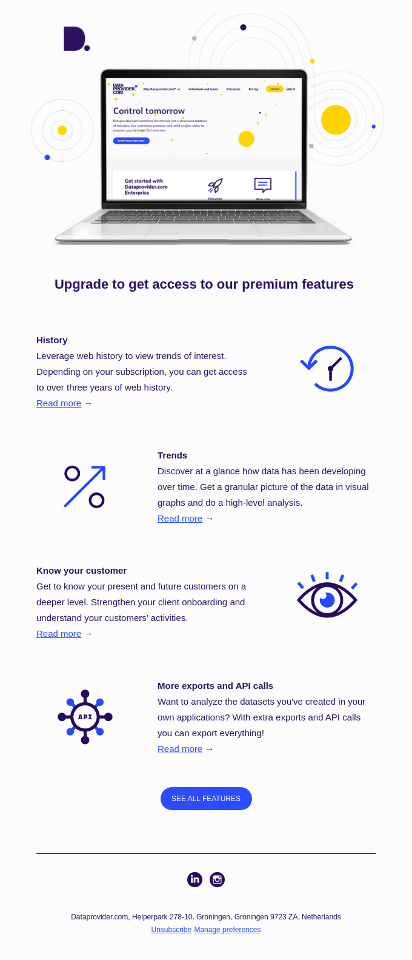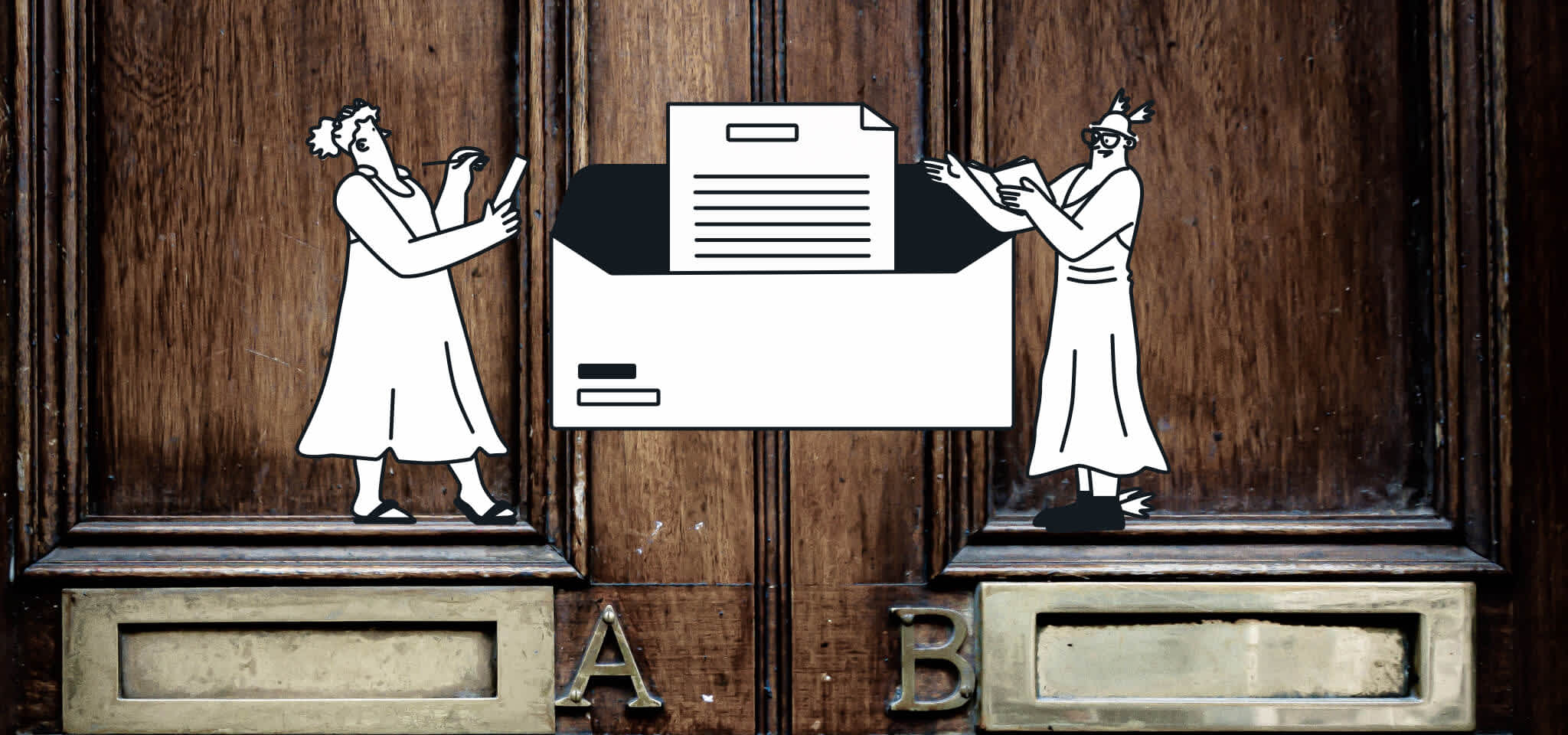Email best practices
Email marketing strategies for small businesses
Email is the best marketing channel for businesses at any stage of their growth – including SMBs. Learn how it can help your company and the essential tips and strategies small business marketers should know.

PUBLISHED ON
There was a time when paid advertising was king for small businesses. But local TV spots, direct mail, and prominent billboards are now considered costly and difficult to track.
Now, traditional advertising has been usurped by email marketing. Its impressive return on investment (ROI) and its ability to amplify other marketing initiatives make it the best channel for businesses at any stage of their growth – including SMBs.
Email marketing is easy to implement and deploy, even for beginners. Today, we will walk through the essential tips and strategies every small business marketer should know.
Table of content
Email marketing is different
Building your first email list
Designing templates for your email marketing campaigns
The welcome email
The upsell opportunity
The sale
The newsletter
The re-engagement campaign
The anniversary email
Table of content
01Why email marketing is a great tool for SMBs
02Main benefits of email marketing for SMBs
03Steps SMBs should follow to get started with email marketing
0411 key email marketing tips for SMBs
056 great email marketing campaigns every SMB should incorporate
06Boost your small business email marketing strategy with Mailjet
Why email marketing is a great tool for SMBs
If there’s something all SMBs have in common is they don’t have money to burn. And while some marketers might argue there is no such thing as expensive or cheap marketing – only marketing that works and marketing that doesn’t work –, some channels are definitely more cost-efficient than others. Email marketing is undoubtedly one of those.
Most other modern marketing strategies come with pre-loaded costs and a significant element of risk. Whether you are paying for paid search ads on a major search engine, sponsored social media posts, or more traditional print media or broadcast advertising, you commit budget upfront and have no guarantee of success. What's more, the more competitive your industry, the more expensive those ads will be. This inconvenient fact is especially bad news for small companies trying to muscle their way into a market dominated by bigger players.
Email marketing is different
Email marketing is typically charged by either the number of emails a marketer sends or the size of their email lists. For small businesses just starting out, this means that costs can be incredibly low or even free. For example, a small business using Sinch Mailjet to power their email campaigns can send up to 6,000 emails to their customer base every month at zero cost. Then, as that small business grows, the next level (15,000 emails per month) starts at just $15 per month. If you think about that for a moment, that's a whole month's worth of marketing for the price of just a few clicks on a paid search campaign.
You can think of email marketing as a genuinely scalable marketing solution that grows with your business. Low costs are great, but for any marketing strategy to ever be considered useful, it needs to have real benefits for the marketer.
Thankfully, email delivers incredible benefits for marketers who follow some simple rules.
Main benefits of email marketing for SMBs
Email marketing’s superpower is based on the fact that it is a nurturing and retention marketing strategy. Most other forms of marketing are acquisition strategies. As anyone who has been in business for any length of time will tell you, it is always more expensive to acquire a new customer than it is to retain an existing one.
With every great superpower comes great responsibility. The first rule of email marketing is that it should only be used to engage existing clients and subscribers who have given you permission to contact them using a signup form. Everything else is spam, and – trust us – it’s not worth it. Spam is illegal, will ruin your reputation, and never delivers on its promise.
The second rule of email marketing is that your campaigns should always be relevant, engaging, and timely. Essentially, this means sending the right message to the right person at the right time.
Get these two rules right, and email can deliver an incredible ROI for your small business. Some estimates suggest that email delivers an average ROI of $36 for every dollar spent. When you consider that average returns from paid search campaigns are estimated at just $2 for every dollar spent, you’ll begin to understand the power of email.
The profitable component of everything else you do to market your business
Suppose you spend money on potentially expensive acquisition marketing such as paid search or sponsored social media posts. In that case, email marketing will help you deliver a greater return on that investment by helping you drive repeat purchases and building customer lifetime value (CLV).
Due to the high cost of acquisition marketing, many businesses might not generate a profit from their initial engagement. Email marketing ensures that those expensively won customers become profitable in as short a period as possible. Remember, if you are paying to acquire the same customer every time you win a sale from them, long-term profitability might not always be a given. Email marketing will help you achieve this goal.
Steps SMBs should follow to get started with email marketing
Great email starts with a solid list of subscribers. There are several methods small businesses can use to build out their lists. These include:
Following a sale.
Following a request for more information or newsletter subscription.
Following the download of an ebook, whitepaper, online catalog, video, or podcast.
Following the registration for an online event or webinar.
Important: Regardless of how you collect email addresses, you always need to ask your potential subscribers for their permission to join your lists. Your email subscribers should also be given the opportunity to leave your lists using an unsubscribe link with every subsequent send. These measures will ensure you stay compliant with global email regulations, including GDPR, CAN-SPAM, and CCPA.
Building your first email list
You’re probably wondering – when should I send my first newsletter? Is it better to send my first email to a few subscribers or should I wait until my list has grown?
The answer is quite simple: If you’re asking people to join your mailing list, make sure you’re ready to start sending emails shortly after they join. Don’t wait until your email lists have reached a significant number of subscribers before sending their first campaign. When subscribers join your list, they have expressed an immediate desire to hear from you – so don’t let them down.
It's also important to remember that email addresses may have a limited shelf life. The average age of an email address is only 16-months. People change jobs and email clients, and sadly nobody lives forever. If you wait too long before sending, your email bounce rate will be much higher than it should be.
Designing templates for your email marketing campaigns
Email marketing is mostly template-driven, which means new campaigns can be created and deployed quickly and efficiently. This will help your small business react to challenges and opportunities as and when they arise.
The ability to deploy a relevant, engaging, and timely email campaign means that if an email marketer can think of an email campaign, they can send it – quickly and efficiently.
For small business marketers, this ability to react quickly can offer a considerable advantage over larger organizations that may have to follow more bureaucratic procedures before a campaign is deployed.
11 key email marketing tips for SMBs
Once you’ve got your first contacts and have developed a few templates to meet your email needs, you’ll be ready start sending. Here are a few tips to keep in mind for a successful email marketing strategy.
Set your objectives: Every email you send should have an objective. Do you want to sell more, drive website visitors, or position your organization as a “thought leader” in your industry? If you don’t set an objective, you’ll never know if your campaigns have been successful or not.
Segment your lists: List segmentation is a great early strategy for ensuring you only ever send relevant emails to your target audience based on the individual requirements of their demographic. Remember, email marketing success is all about sending the right message to the right person at the right time. Failure to follow this rule will cause subscribers to disengage from your lists quickly.
Tell the full story with your subject lines: Your subject line is your first line of defense between your business and obscurity. You should write your subject lines with the same care as a newspaper editor writes their headlines – in a catchy, attention-grabbing way. A great subject line will tell the full story and let subscribers know precisely what they will get if they open the email.
Get personal: A great way to make your emails stand out is to include your subscriber's name in the subject line. This tactic is the first step on a wider email marketing personalization strategy that can evolve as your experience grows.
Open your email with strong content: While you might be tempted to get creative with your design skills, the top section of your email body content should always include some powerful copy. This is because images may initially be blocked by your subscriber’s email client, leaving a big empty space at the top of your body content. Text will always render and encourage the subscriber to commit and download any unseen images.
Remember less is indeed more: Get to the point. The average office worker receives more than 100 emails every day. They literally have seconds to make a decision about whether they want to engage with your campaign or not. So don't waste their time with unnecessary text and irrelevant offers.
Create a compelling call-to-action (CTA): Every email needs a compelling CTA. Don't expect your subscribers to understand (or even care) what it is you want them to do after opening and reading your promotional emails. Instead, a compelling CTA should point them in the right direction by explaining exactly what will happen next on the customer journey.
Perfect the landing page experience: It doesn't matter how good your subject lines, body text, or CTAs are – if your website isn't optimized for conversions, any investment in email marketing or any other form of marketing will be wasted.
Analyze, test, and optimize: Take the time to learn what strategies work and optimize your campaigns accordingly. A/B testing is a great way to learn how small changes to your campaigns can increase open rates, click-through rates, and conversion metrics.
Maintain good email list hygiene: While you will want to grow your list, it's important to remember that old and unresponsive email addresses will never drive any revenue. They may also damage your ability to send future campaigns, as bounced emails are often an indicator of unscrupulous email practices used by potential spammers. That’s why list hygiene is essential. If a subscriber hasn't opened a campaign in some time, it may be worth sending a re-engagement campaign and ultimately removing any deadwood from your list.
Be persistent – it pays off: Too many marketers restrict their email campaigns to irregular newsletters, believing they might annoy their subscribers if they send too many messages. This is an unfound fear.As long as your emails are relevant, engaging, and timely, you’ll struggle to send too many emails. Remember, your subscribers have given you permission to contact them, so don’t waste that opportunity and keep in constant contact.
6 great email marketing campaigns every SMB should incorporate
Many small business marketers will initially engage with email marketing with the idea of sending a weekly or monthly email newsletter. While regular newsletters are an important component of any email marketing strategy and are especially useful in driving traffic to other marketing channels, they are not the only campaign strategy small business marketers can deploy.
These campaigns include:
The welcome email
In many ways, the first email you send to an individual subscriber will always be the most important one. The moment following a subscription via a sale or registration is when that subscriber is at their most engaged. That's why it's always a good idea to create and send every new subscriber a welcome email automatically triggered by their subscription.

Impossible welcomes its subscribers to the team with this colorful and delectable welcome email. From the top-down, they have a personalized “Welcome Smiles Davis” greeting, followed by a fun intro that incorporates their ethical mission statement. Their objective is clear: to direct their audience to the shiny yellow CTAs where they can learn more or find a store.
The upsell opportunity
When a customer makes a purchase, they share incredibly valuable information that can be used to create more targeted marketing campaigns. These campaigns will demonstrate that you are taking the time to understand your customers' needs and create the opportunity to build customer lifetime value. If an expensive acquisition marketing campaign influenced that initial purchase, that upsell marketing campaign could be your first step toward creating a profitable relationship.

Small business Dataprovider.com offers customers on free accounts the chance to upgrade to paid premium features. The email is designed to show customers the benefits of upgrading, with visual icons that lead the eye down to the CTA. Everything here moves the reader down the sales funnel to decisive action.
The sale
Approach with caution. While everyone loves a good deal, persistent discounting may reduce your ability to ever sell at full price again. Soif you are offering your loyal customers a discount, make sure you highlight these as "end-of-line" special offers or very occasional seasonal offers.

Bellroy emphasizes scarcity by putting the words “limited,” “rare,” and “last chance to buy” on the main headers. They want the reader to understand that deals like this don’t come around often. If Bellroy were to send this type of email out every month, their readers would lose trust in the brand and likely feel manipulated.
The newsletter
Nothing will drive traffic to your thought leadership content faster than an email newsletter. This is a great move for businesses hoping to position themselves as experts in their particular industry. A thought leadership campaign will take people from their inboxes to your latests blog articles, ebooks, whitepapers, webinars, podcasts, and videos.

We don’t like to toot our own horn (too much), but the Mailjet team has spent years writing email marketing thought leadership content. This means our newsletters offer valuable insights to our subscribers, positioning us as authorities amongst email service providers. Small businesses can also be authorities within their industry by hiring skilled content marketers, working with freelancers, or guest writers.
The re-engagement campaign
Not heard from a client in some time? Don’t let them become strangers. Instead, how about reeling them back into your sphere of influence with a re-engagement campaign that reminds them how they value your business? The re-engagement campaign is also a vital component of your list hygiene strategy.

Language app Duolingo understands that its users often start off motivated when learning a new language, but their enthusiasm wanes as time goes on. A little bit of encouragement from an owl will be enough for some users to “get back on track.” By not being too imposing, readers may quickly brush aside the email instead of hitting that dreaded unsubscribe button.
The anniversary email
Have you ever worked somewhere where they remember your work anniversary? It’s nice, right? Customers also appreciate this kind of gesture and anniversary emails remind them of the longevity of their relationship with you. Why not throw in a free treat, a discount, or even a poem for good measure? After all, it is their anniversary!

Grammarly uses a potent mixture of personalization, upselling, and automation to create this anniversary email. Time together is often the best metric for a relationship, and Grammarly reinforces this with a birthday cake and a big number one candle on top. Now they have your attention, a heartfelt message offers you a “special reward.” It’s a masterstroke of email design that has undoubtedly converted some free users to paying customers.
Boost your small business email marketing strategy with Mailjet
So there you have it – our email marketing cheat sheet for small companies. As you’ve seen, many of the ideas covered here are not technical, but they do take a human-first approach. Good email marketers put subscribers' thoughts and feelings front and center, which cultivates long-term customer loyalty.
Email marketing is like cooking: It’s easy to learn, but hard to master. That’s why we created the Email Growth Playbook – a micro-site filled with tactics to boost your email ROI. Here, you can filter relevant content as you progress from beginner to intermediate and then advanced email marketing skillset.
Looking for a great email provider to kickstart your email strategy? Mailjet offers small businesses a free email marketing platform, enabling you to send 6,000 emails to unlimited contacts. Create beautiful emails with our drag-and-drop Email Editor and measure success with our easy-to-understand analytical tool. As your business grows and your campaign strategies become more sophisticated, Mailjet’s scalable solution grows with your needs and requirements.








